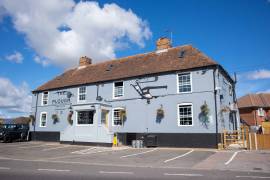A brief history of binge-drinking
Binge-drinking, I hardly have to mention, is big news.
Barely a day goes by without a politician or police force pledging to make a stand against vomiting teens, public urination or cider-can-wielding hooligans.
Drinks companies have reacted too, with the launch of a multitude of "responsible drinking" campaigns.
But is this really such a recent phenomenon? As consumer education campaigns by companies including Diageo and SABMiller rumble on, we take a moment to reflect on our historical battle with the demon drink and previous attempts to curb consumption.Oliver Cromwell 1653-1658
What a spoilsport Oliver Cromwell was. Not content with doing away with that old wag Charlie, he went and took the fun out of having a swift one down the local as well.
After all, where's the fun in getting a bit tipsy if you can't have a bit of a sing-song, eh? In a Puritan crusade against the evils of drink, he banned all games, sports, dancing and singing except in churches, in an attempt to reduce the atmosphere of the average inn to something comparable to a 6.15am Reading-to-London commuter train.
His bid to dry out his permanently drunk citizens also led him to withdraw or refuse licences for many alehouses and taverns. Did it work? Nah.
The gin laws 1729-1743
English troops returning home from the Thirty Years War started the biggest national knees-ups ever when they brought a sackful of the perilous tipple gin home with them.
Beer was more expensive and the water quite literally tasted of poo, so a taste for gin quickly developed among the poor. Anyone could distill it as long as they posted a public notice and then waited 10 days.
This kind of entrepreneurial flair and a bit of marketing gusto meant that before you could say "drunk for a penny, dead drunk for two" most of London was inebriated.
In 1729, an excise licence of £20 and a duty of two shillings per gallon was introduced, which managed to suppress good gin, but production of the ropey illegal stuff soared.
The population of London dropped as people literally drank themselves to death. In 1736, the government had another stab at it and decreed a £50 licence was needed to sell the stuff. Rioting ensued as mobs took to the streets in a frenzy to buy gin before the law came in.
They needn't have bothered, because while only two distillers purchased a licence, production rose by 50 per cent.
So in 1743, the Gin Act was recognised as unenforceable and was effectively repealed.
The temperance movement 1832-1900
Like many crazes, the temperance movement started in the US, in 1789, before the slightly less happening and with-it folk of Blighty finally picked up on the fad in 1832.
Whereas the American movement mainly called for drinking in moderation, the Brits, never ones for subtlety, decided nothing but total abstinence would do. Various groups sprung up over the following years, mainly in the North of England, to protect people from the perilous drink.
Then in 1853 a bunch of jokers calling themselves the United Kingdom Alliance decided to lobby the government for a law prohibiting the sale of alcohol. But in 1859 a draft prohibition bill was almost unanimously defeated in the House of Commons and that was that, although lobby groups continued to form until the turn of the century.
The Defence of the Realm Act 1914
Well now, here's a drinking law that's hard to oppose. In order to stop huge swathes of World War I munitions workers turning up to work pickled which was of course very funny but did slow production down awfully the government took control of the pubs in Carlisle and Gretna, Cromarty Firth and Enfield, where the major munitions factories were, under the Defence of the Realm Act.
Under the Act, publicans were replaced with civil servants who were not allowed to let people get drunk, opening hours were cut from 5am to 12.30am to midday to 3pm and 6.30pm to 9.30pm, beer was watered down and people were forbidden from buying rounds of drinks.
One man was even fined for buying his wife a drink. Oh, and you also weren¹t allowed to buy binoculars or feed wild animals. As a result, both consumption and arrests for drunkenness fell dramatically. It was not until 1973 that the government-owned pubs were sold off.
US prohibition 1920-1933
On January 16, 1920, in order to improve health, solve social problems and reduce crime, all importing, exporting, transporting, selling and manufacturing of intoxicating liquor (anything over 0.5 per cent) was banned in the US.
Unfortunately the move increased ill-health, social problems and crime. For a start, those cheeky Americans started necking medicinal alcohol at an alarming rate, sales of which rose by 400 per cent during prohibition.
People made their own, smuggled it in from abroad or went to a speak-easy. Gangsters took control of the illegal trade and violent gang wars erupted.
Deaths from alcohol and arrests for disorderly conduct both increased. A big fat political whoopsie if ever there was one. National prohibition ended on December 5, 1933. Sadly no-one thought to tell Mississippi, which didn¹t lift the ban until 1966.













